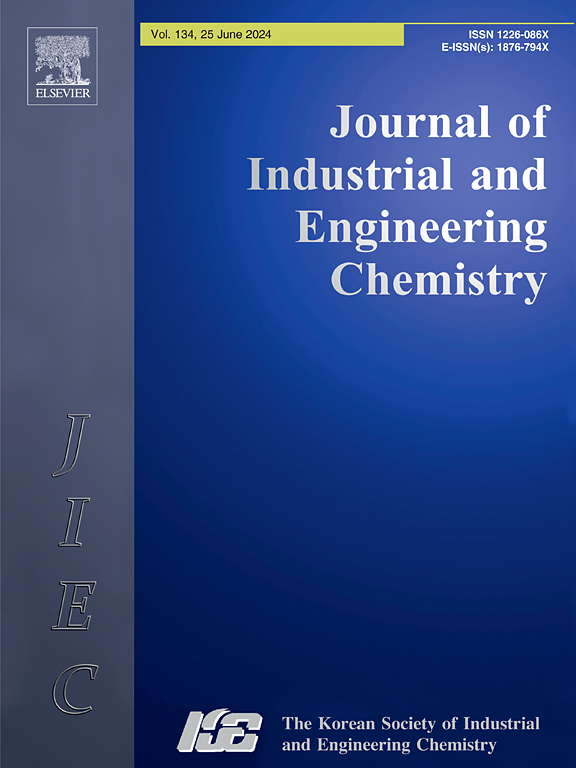Fabrication of dopamine/TiO2 nanocomposite hydrogel using fenugreek gum for efficient photocatalytic degradation of organic pollutants under visible light irradiation
IF 5.9
3区 工程技术
Q1 CHEMISTRY, MULTIDISCIPLINARY
Journal of Industrial and Engineering Chemistry
Pub Date : 2025-01-25
DOI:10.1016/j.jiec.2024.07.019
引用次数: 0
Abstract
The efficient removal of organic pollutants from wastewater is a global challenge and poses a significant threat to public health and ecosystems. In this study, we synthesized a novel fenugreek gum-based polymer functionalized with dopamine (DA) and monomers dimethylamino ethyl methacrylate (DMA), acrylamide, and N, N, methylene bis acrylamide (MBA) as a crosslinker and TiO2 nanocomposite hydrogel photocatalytic degradation for environmental remediation. The nanocomposite hydrogel was determined using various analytical techniques such as FT-IR, XRD, FESEM, EDX, DRS-UV, TEM, LC-MS, and XPS. The optical band gap was at 2.81 eV, calculated from UV–visible DRS spectra. The XRD confirmed the crystalline and anatase phases. TEM, EDX, and XPS analyses defined the size, shape, chemical composition, and purity of synthesized FNG/DDM/TiO2 nanocomposite hydrogel. The resulting nanocomposite hydrogel photocatalyst effectively degraded hazardous pollutants such as methylene blue (MB) and Congo red (CR) organic dyes under visible light irradiation. The decomposition efficiency of Congo red is 95.27 % within 75 min and methylene blue is 73.26 % within 150 min. Moreover, the results of the trapping experiment revealed that the active species in the photocatalytic degradation process are holes (h+) and super oxide radicals (.O2-), more reactive species. The probable degradation intermediates and the degradation pathway were analyzed by LCMS analysis, and the degradation fragments formed during Congo red (CR) dye degradation were identified. The recyclability and stability were studied in the presence of a photocatalyst, achieving 90.5 % degradation after four cycles. The FNG/DDM/TiO2 hydrogel also effectively removed dyes from wastewater containing organic pollutants. The novel FNG/DDM/TiO2 nanocomposite hydrogel, synthesized through an environmentally friendly polymer, demonstrated high efficiency in degrading organic dyes, excellent recyclability with robust structural stability, and significant potential for photocatalytic degradation of wastewater across various industries.

利用葫芦巴胶制备多巴胺/二氧化钛纳米复合水凝胶,在可见光照射下高效光催化降解有机污染物
有效去除废水中的有机污染物是一项全球性挑战,对公共卫生和生态系统构成重大威胁。在本研究中,我们合成了一种以多巴胺(DA)和单体甲基丙烯酸二甲胺乙酯(DMA)、丙烯酰胺、N, N,亚甲基双丙烯酰胺(MBA)为交联剂的新型胡芦巴胶基聚合物,并与TiO2纳米复合水凝胶光催化降解用于环境修复。采用FT-IR、XRD、FESEM、EDX、DRS-UV、TEM、LC-MS和XPS等分析技术对纳米复合水凝胶进行了表征。根据紫外-可见DRS光谱计算,光学带隙为2.81 eV。XRD证实了晶相和锐钛矿相的存在。TEM、EDX和XPS分析确定了合成的FNG/DDM/TiO2纳米复合水凝胶的尺寸、形状、化学成分和纯度。制备的纳米复合水凝胶光催化剂在可见光照射下可有效降解亚甲基蓝(MB)和刚果红(CR)有机染料等有害污染物。75 min内刚果红的分解效率为95.27%,150 min内亚甲基蓝的分解效率为73.26%。此外,捕集实验结果表明,光催化降解过程中的活性物质为空穴(h+)和超氧自由基(. o2 -),活性物质较多。利用LCMS分析了可能的降解中间体和降解途径,鉴定了刚果红(CR)染料降解过程中形成的降解片段。在光催化剂的存在下,研究了其可回收性和稳定性,经过4次循环后,降解率达到90.5%。FNG/DDM/TiO2水凝胶还能有效去除含有机污染物废水中的染料。新型的FNG/DDM/TiO2纳米复合水凝胶是由一种环保聚合物合成的,具有高效降解有机染料、良好的可回收性和良好的结构稳定性,在各种工业废水的光催化降解中具有重要的潜力。
本文章由计算机程序翻译,如有差异,请以英文原文为准。
求助全文
约1分钟内获得全文
求助全文
来源期刊
CiteScore
10.40
自引率
6.60%
发文量
639
审稿时长
29 days
期刊介绍:
Journal of Industrial and Engineering Chemistry is published monthly in English by the Korean Society of Industrial and Engineering Chemistry. JIEC brings together multidisciplinary interests in one journal and is to disseminate information on all aspects of research and development in industrial and engineering chemistry. Contributions in the form of research articles, short communications, notes and reviews are considered for publication. The editors welcome original contributions that have not been and are not to be published elsewhere. Instruction to authors and a manuscript submissions form are printed at the end of each issue. Bulk reprints of individual articles can be ordered. This publication is partially supported by Korea Research Foundation and the Korean Federation of Science and Technology Societies.

 求助内容:
求助内容: 应助结果提醒方式:
应助结果提醒方式:


